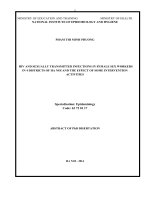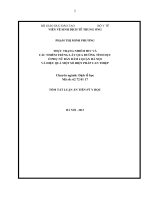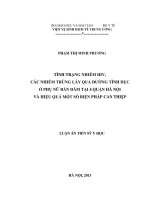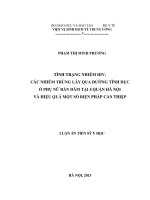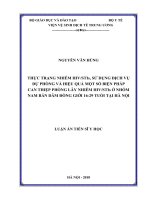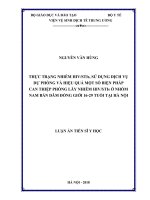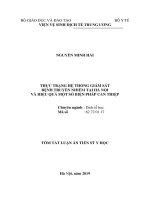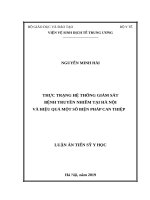thực trạng nhiễm hiv và các nhiễm trùng lây qua đường tình dục ở phụ nữ bán dâm 4 quận hà nội và hiệu quả một số biện pháp can thiệp bản tóm tắt tiếng anh
Bạn đang xem bản rút gọn của tài liệu. Xem và tải ngay bản đầy đủ của tài liệu tại đây (1.29 MB, 28 trang )
1
Ministry of Education and Training Ministry of Health
National Institute of Epidemiology and Hygiene
PHAM THI MINH PHUONG
HIV AND SEXUALLY TRANSMITTED INFECTIONS IN FEMALE SEX WORKERS
IN 4 DISTRICTS OF HA NOI AND THE EFFECT OF SOME INTERVENTION
ACTIVITIES
Specialization: Epidemiology
Code: 62 72 01 17
ABSTRACT OF PhD DISERTATION
Ha Noi - 2014
2
The work is completed in:
National Institute of Epidemiology and Hygiene
Thesis advisor:
1. Ass.Prof. TRẦN HẬU KHANG, PhD
2. Ass.Prof. NGUYỄN ANH TUẤN, PhD
Opponent 1: Prof. Dao Van Dung, PhD
The Central Department of Propaganda and training
Opponent 2: Ass. Prof. Ho Ba Do, PhD
The Military Medical Insitute
Opponent 3: Ass. Prof. Tran Dang Quyet PhD
The Military Medical Insitute
The thesis will defensed at Institutional commitee in National Institute of Epidemiology and Hygiene
at , date month year
Full disertation could be found at
- National Library
- The library of National Institute of Epidemiology and Hygiene
3
Scientific articles published
1.
Pham Thi Minh Phuong, Tran Hau Khang, Nguyen Anh
Tuan (2012), “HIV prevalence and risk related behaviors
in female sex workers in Hanoi, Vietnam 2005-2006”,
Journal of Preventive Medicine. 6(133), pp.55-63
2.
Pham Thi Minh Phuong, Tran Hau Khang, Nguyen Anh
Tuan (2013), “Assessment of intervention to reduce
HIV/STI risk among female sex workers in Hanoi 2005-
2010”, Journal of Preventive Medicine. 3(139), pp.66-73
3.
Pham Thi Minh Phuong, Tran Hau Khang, Nguyen Anh
Tuan (2013), “Chlamydia prevalence and behavioral risk
among community female sex workers in Hanoi 2005-
2006”, Journal of Preventive Medicine. 7(143), tr.56-63
4
ABREVIATION
INTRODUCTION
1. Justification for the study
Sexually transmitted infections (STI) including HIV are big public
health issue. Prostitution plays an important role in transmitting
HIV/STI, therefore HIV/STI prevention for sex workers is one of the key
activities in HIV program. In Vietnam, National strategy on HIV/AIDS
prevention and control claims that STI counseling and management for
high risk group need to be strengthen. A study on HIV/STI epidemiology
and intervention for female sex workers is necessary for making
HIV/STI prevention plan. Therefore, the study “HIV/STI situation in
Acronym
AIDS Acquired Immuno-Deficiency Syndrome
FSW Female sex worker
HCM City Ho Chi Minh City
HIV Human Immunodeficiency Virus
PCR Polymerase Chain Reaction
RPR Rapid Plasma Reagin
STI Sexually Transmitted Infection
TPHA Treponema Pallidum Haemagglutination Assay
5
female sex workers in 4 districts of Ha Noi and the effect of some
intervention activities” was implemented.
2. Study objectives:
− To describe the HIV/STI situation and related factor among
FSW in 4 districts of Ha Noi 2005 – 2006.
− To evaluate the effectiveness of some HIV/STI control
intervention activities in FSW in Ha noi 2005-2010.
3. New findings of the dissertation
The dissertation has provided new information about HIV/STI
prevalence of FSW in 4 districts in Ha Noi at 2005-2006 and at 2009-
2010 and about HIV/ Chlamydia infection related factors among FSW at
2005-2006. The dissertation has also evaluated some intervention
activities aiming to HIV/STI control in FSW group.
4. Scientific and confident issue in the thesis
The study used quasi-experimental study with pre and post
intervention comparison. The sampling and sample size, data collection
instrument including questionnaire and laboratory tests, data analysis
were relevant, thus the results are scientifically confident.
5. Outline of the dissertation
The dissertation is 123 page length excluding table of content, list
of tables, list of figures, appendix and 131 references. The dissertation
includes: introduction, literature review, methodology, results,
discussion, conclusion and recommendation part, 32 tables and 15
figures.
CHPATER ONE: LITERATURE REVIEW
1.1. Prostitution situation in the world and in Viet Nam
Commercial sex worker group is stigmatized over the world.
Prostitution is considered illegal, therefore it is very difficult to access
6
and trace them. Female sex worker (FSW) group is considered one of the
high risk group and they play an important role in HIV epidemic. There
are 2 type of FSW: direct and indirect FSW. Direct FSW income comes
from selling sex activity only. They sell sex on streets and brothels.
Indirect FSW income comes from selling sex and from other jobs such as
massage girl, hair dresser and waitress in hotel/restaurant.
In Viet Nam, prostitution is illegal and considered as a social evil.
Police and local authorities carry out campaign to attack FSW. If
arrested, FSW will be brought to rehabilitation center where they get
STI/HIV checking/ treating and vocational education.
1.2. HIV/STI situation and related factors in FSW
1.2.1.HIV/STI situation in FSW
HIV: Africa is the place having very high HIV prevalence in FSW
(19%). In Asia, HIV epidemic is concentrated in some special
populations such as intravenous drug user and sex worker. In China, HIV
sentinel surveillance reveals that HIV prevalence in sex worker is
increasing. In India, HIV prevalence in FSW is 5%. In Viet Nam, HIV
prevalence in FSW is higher than 10% in some cities/provinces and tends
to increase in some other provinces. In the period of 2003-2011,
according to HIV sentinel surveillance, the HIV prevalence in this group
was around 3-5%. However, in some place, HIV prevalence was very
high such as in Lang Son (17.6%), Can Tho (10.67%) and was low such
as in Da nang (0.6%) and Khanh Hoa (1.1%).
Gonorrhea: Gonorrhea prevalence in FSW in Yunnan (China) was
37.8%, in Cambodia was 12%, in Indonesia was 28.6%. In Viet Nam,
gonorrhea prevalence was 3% in Ha Noi, 0.5% in HCM city, 5.3% in Hai
Phong, 20.2% in Lai Chau, 24.8% in Quang Tri, 7.3% in Dong Thap,
5.7% in An Giang, 9.4% in Kien Giang and 14.9% in Soc Trang.
7
Syphilis: Syphilis prevalence in FSW was 8% in Quang Dong,
2.3% in Cambodia. In Viet Nam, the prevalence in street based FSW and
in venue based FSW was 9.1% and 7.3% in HCM city, 5.5% and 5.8% in
An Giang, 3.0% and 5.4% in Da Nang, 5.6% and 0.3% in Can Tho, 3.2%
and 2.2% in Hai Phong.
Chlamydia: Chlamydia prevalence in FSW in Yunnan (China) was
58.6%, in Cambodia was 14%. Some studies inViet Nam showed that
Chlamydia prevalence in FSW was 48.4% in Soc Trang, 5% in Ha Noi,
3.3% in Hai Phong, 3% in Quang Ninh, 6.5% in HCM city and 3.5% in
Da Nang.
1.2.2. The association between some behaviors and HIV/STI
A study in Quang Dong (2010) showed that high education level
and good STI knowledg were protective factor that could reduce the risk
of STI. The behavior of inviting clients on street or in hotel, getting more
money for selling sex was associated with higher risk of STI. According
to a study in Jamaica, age, using drug, not using condom in the last sex
were high risk behaviors of getting HIV in FSW.
A study in HCM city, Can Tho, An Giang revealed that the age
under 30, genital ucer, inconsistent condom use were associated with
higher risk of HIV. A study in Hai Phong showed that good STI
knowlegd was a protective factor while having more than 4 clients per
week, self STI treatment, poor knowlegd on condom use associated with
higher risk of STI. A study in Hue in 2008 also proved that low
education level and incorrect condom use were considered high risk
behavior.
1.3. Some interventions to reduce HIV/STI in FSW
In Thailand, interventions including information education
communication activities, strengthening condom use and STI
management helped to increase consistent condom use and decreased
8
STI prevalence in FSW, HIV prevalence in community got stable and
finally decreased. In 2003, an intervention in India including
communication for bahavior change, increasing condom use, regular STI
screening, periodical STI check also increased condom use with regular
clients, decreased HIV and some STI prevalence.
A study in Vinh Long showed that after 2 year intervention,
knowlegd on how to prevent HIV got increased, consistent condom use
with regular clients and husband/boyfriend got improved. However, HIV
prevalence did not decreased after the intervenion. Another intervention
for FSW in Ha Tay showed that after intervention, consistent condom
use with regular and irregular clients did not change, but with boyfriend
got increased. In venue based FSW, consistent condom use with irregular
clients and with boy friends got improved, but with regular clients did
not. The percentage of people who knew STI symptoms did not improve
(p>0.05). After intervention, prevalence of genital discharge, lower
abdominal pain and genital ulcer syndrom decreased significantly.
1.4. Some information about Ha Noi
HIV prevalence in FSW in Ha Noi is very high in comparison with
that of the whole country. According to HIV sentinel surveillance, HIV
prevalence in FSW group was around 3-5% during the period of 2003-
2011, but that of Ha Noi was 13-16% during the period of 2003-2005.
The cumulative HIV number at the end of each year in this period of
Thanh Xuan and Cau Giay were lowest and that of Hai Ba Trung and
Dong Da were highest in compare with other districts. In Ha Noi,
prostitution situation is complicated. Karaoke bar is one of the places of
prostitution activities. A master often hires a place to gather 10-15
FSWs, prints name cards to distribute to entertainment places such as
karaoke bars, restaurants, hotels. The heads of these entertainment places
will call the master if necessary. Each FSW carries a number for easy
9
and confidential contact. Prostitution brings much profit, therefore many
entertainment places get involved in. In addition, the monitoring
activities of local authorities do not strong enough; many tourists go to
Viet Nam for prostitution leading to complicated prostitution situation.
CHAPTER 2
METHODOLIGY
2.1. Study subjects
The subjects of the study were FSWs in community of Ha Noi,
including 2 groups: street based and venue based FSW.
2.2. Place and time
The study was implemented in 4 districts of Ha Noi: Dong Da, Hai
Ba Trung, Thanh Xuan, Cau Giay.
Study was carried out from 2005 -2010. Pre intervention survey
was from 2005-2006 and post intervention survey was from 2009-2010;
Intervention was implemented from 2006-2009.
2.3. Study design
This is an quasi experimental study with pre/ post intervention
comparision. Pre intervention and post intervention survey were cross
sectional survey with cluster sampling.
2.3.1. Sample size
Formular for sample size calculation:
D = 1.3; P
1
= 0.6; P
2
= 0.75; α = 0.05; β = 0.90
The necessary sample size is at least 215 FSWs.
10
2.3.2. Sampling:
In pre and post intervention survey, 2 stage cluster sampling was
used.
Stage 1: Sampling frame development and cluster selection. Mapping
technique was use to establish sampling frame which included all places
where FSW could be reached. Cluster is a group of at least 10 FSW. The
list of all clusters was used as sampling frame and 30 clusters in the list
were chosen randomly.
Stage 2: Study subject selection. If in a cluster, the number of FSW at
the time of selection was larger than 10, the subject has been chosen
randomly. If the number was less than 10, all of the FSW at that time have
been selected and the investigator had to come back later to select more
FSW until geting 10 FSW.
2.4. Study activities
Questionnaire development and piloting
The questionnaire was developed by experienced expert and tested/
adjusted before being used.
Interviewer selection and training
All of interviewers were experienced staff and they had been trained
on mapping technique and how to implement a survey.
Data collection
After getting to the interview place, study subjects got registered at
reception area, and then were interviewed. After interview, urine and blood
samples were collected. The urine samples were used for gonorrhea and
Chlamydia detection by PCR at National Institution of Epidemiology and
Hygiene (NIHE); Blood sample was used for HIV and syphilis detection
test at Hanoi HIV/AIDS Center.
2.5. Intervention
11
Intervention activities were carried out by Women Health care
Center. The activities included STI services at the Center, mobile STI
services, counseling on HIV/STI, condom use promotion, condom and
clean syringe/needle provision.
2.6. Data analysis
EPI INFO 6.04 was used to enter data. SPSS soft ware was used for
data analysis. Descriptive and frequency analysis, T test, Chi square test,
OR and 95% confidence interval were used. The statistical significant
level of p ≤ 0.05 was used.
2.7. Bias reduction
In order to reduce the bias, investigators were experienced in public
health survey and got trained before the survey to ensure that they fully
understood their job, the objectives of the study and criteria for each
activity.
The questionnaire was developed by experienced experts and tested
to ensure it was clear, understandable for FSWs, and the answers
reflected the truth.
All of the subjects were coded, anonymous so that they felt
comfortable to give the right answers.
All of the lab test including HIV test, syphilis test and PCR for
gonorrhea and Chlamydia detection were implemented in standard
laboratory with high sensitivities and specificities. Therefore, the results
of lab tests are trustable.
2.7. Human subject
All of the subjects participated into the study voluntarily. Their
personal information was kept confidentially. The intervention activities
were safe and were not harmful for them. The study was approved by
NIHE institution reviewing board.
12
CHAPTER 3: RESULTS
Pre intervention survey recruited 499 FSW (275 venue based FSW
and 224 street based FSW). Post intervention survey recruited 600 FSW
(300 venue based FSW and 300 street based FSW).
3.1. HIV/STI situation and related factor in FSW in 4 districts of Ha
Noi 2005-2006
3.1.1. HIV/ STI prevalence in FSW
Figure 3.4. HIV prevalence by FSW type and by drug use behavior
The survey 2005-2006 showed that 16.6% FSW got HIV infected.
According to figure 3.4, HIV prevalence of street based FSW was higher
than that of venue based FSW (p=0.0001), HIV prevalence of people
who used drug was higher than of people who did not (p=0.0001) and of
who injected drug was higher than who did not (p=0.0001).
13
Figure 3.5. STI prevalence in FSW of Ha Noi before intervention
According to figure 3.5, syphilis prevalence in street based FSW
was 1.1% and in venue based FSW was 0.4% (p=0.39). Gonorrhea
prevalence in both FSW groups was 1.8%. Chlamydia prevalence in
street based FSW was 17.5 and in venue based FSW was 8.5%
(p=0.003).
3.1.2. HIV/STI related factors
3.1.2.1. Age of selling sex, duration of being prositution and the number
of clients of investigated FSWs
FSW started to sell sex when they got around 24 years old. The
mean age of selling sex of street based FSW was higher than of venue
based FSW (25.2 vs 22.9; p=0.0001, t test). The mean of duration of
selling sex was 4,1 year, that of street based was 4,4 year, longer than of
venue based FSW (3.7 years) (p=0,047, t test). FSWs had around 21.7
clients monthly including 14.8 irregular and 5.5 regular clients. The
number of regular and of irregular clients monthly of street based FSWs
did not different with that of venue based FSWs.
14
3.1.2.2. HIV/STI knowledge of FSWs before intervention
Pre intervention study showed that 87.2% of FSW had heard about
HIV/AIDS. The proportion of FSW who considered themselves at high
risk of being HIV infected was 25.7%. That of street based FSW was
29.8%, higher than that of venue based FSW (20.5%) significantly
(p=0.018). The proportion of FSWs who had sufficient HIV knowledge
accounted for 43.1%, that of venue based FSW was higher than of street
based FSW (51.3% vs 36.4%, p=0.001).
Regarding to STI knowledge, 63.7% of FSWs recognized genital
discharge as a STI sign. Other signs such as pain at passing urine, genital
ulcers/warts and lower abdominal pain were less recognized (accounted
for 28.3%, 14.4% and 20.2% of surveyed FSW, accordingly). The
percentage of FSW who did not know any common STI signs accounted
for 17.8%. The proportion of FSW knowing 4 STI signs was 3.6%
among street based FSWs and was 0.4% among venue based FSW.
3.1.2.3. STI history of FSW in Ha Noi before intervention
Figure 3.8. STI history of FSW in Ha Noi before intervention (n=499)
According to figure 3.8, 46.5% of FSW had genital discharge and
12.8% had genital ulcer/ warts in the year before the pre intervention
survey. The history of genital discharge in the 2 groups of FSW did not
different significantly (p=0.22), but the history of genital ulcer/wart of
15
venue based FSW was less than street based FSW (4% vs 20%,
p=0.0001).
3.1.2.4. Condom use bahavior of FSW in Ha Noi before intervention
Figure 3.9. Consistent condom use in FSW 2005-2006 in Ha Noi
The figure 3.9 showed that the percentage of using condom
consistently with irregular clients among FSW was 76%, higher than
with regular clients (56.6%) and higher than with husband/boyfriend
(17.5%). The percentage of using condom consistently with irregular
clients among venue based FSW was higher than that of street based
FSW (81.2% vs 71.7%, p= 0.02). Consistent condom use with regular
clients among venue based FSW did not different with street based FSW
(57.1% vs 56.1%, p= 0.82). Consistent condom use with
husband/boyfriend among venue based FSW did not different with street
based FSW (17% vs 18%, p= 0.72, Chi square test)
3.1.2.5. Drug use behavior among FSW in Ha Noi before intervention
16
Figure 3.10. Drug use in FSW before intervention
According to figure 3.10, venue based FSW used drug less than
street based (10.3% vs 24.4%, p=0.0001). The percentage of FSW who
injected drug among street based FSW was higher than that of venue
based (16.7% vs 4%; p=0.0001). Among FSW who used drug, 61.1%
injected (among street based: 68.7% and among venue based: 39.1%)
3.1.2.3. Association between behaviors and HIV among FSWs
Table 3.17. Multi-lateral analysis of HIV related factors among FSW
in Ha Noi
Related factor OR 95% CI p
Being street based vs venue based FSW 3.5 1 – 12.7 0.05
Use drug vs not use drug 5.2 0.2 – 149.4 0.33
Inject drug vs not inject drug 0.1 0.01 – 3.0 0.15
Using used needle/syringe in the last
month
87.8 2.8 – 2770.3 0.01
Irregular clients injected vs irregular
clients did not inject
0.9 0.3 – 3.9 0.98
Husband/boyfriend injected vs
husband/boyfriend did not inject
1.6 0.5 – 5.5 0.47
17
Related factor OR 95% CI p
Consistent condom use with irregular
clients vs inconsistent condom use
0.3 0.1 – 0.9 0.04
STI history in the last year vs no STI
history
3.3 0.9 – 11.7 0.06
Age of starting selling sex 0.9 0.8 – 1.1 0.4
Unilateral analysis showed that HIV related factors were age of
starting selling sex, being street based FSW, using drug, injecting drug,
using used needle/syringe in the last month, irregular clients injected,
husband/ boyfriend injected, having STI in the last year, inconsistent
condom use with irregular clients. These factors were put into logistic
regression to find out independent predictors. Figure 3.17 showed that
independent HIV related factors were being street based FSW, using
used needle/ syringe in the last month, inconsistent condom use with
irregular clients. Consistent condom use was protective factor. FSW who
used condom consistently during sex with irregular clients less likely to
be HIV infected (OR=0.3) than other who did not
3.1.2.5. Association between bahaviors with STI
The prevalence of gonorrhea and syphilis were very low,
therefore only Chlamydia related factors was analysed.
Unilateral analysis showed that chlamydia related factors were
being street based FSW, knowing at least 2 STI signs and buying
medicine at drug store for self-treatment if having STI symptoms. These
factors were put into logistic regression to find out independent
chlamydia related factors.
Table 3.22. Multilateral analysis of Chlamydia related factors
18
Related factors OR 95% CI p
Being street based vs venue based FSW 2.3 0.9 – 5.7 0.08
Knowing more than 2 STI symptoms 0.9 0.3 – 2.2 0.74
Buying medicine at drug store for STI self-
treatment
3.6 1 – 12.7 0.05
According to table 3.22, only the behavior of buying medicine at
drug store for self-treatment was independently associated with
chlamydia infection. The FSW who bought medicine at drug store for
self-treatment were 3.6 times more likely to be chlamydia infected (OR=
3.6; 95% CI: 1 – 12.7).
3.2. The effect of the intervention on risky behaviors and HIV/STI
prevalence in FSW of Ha Noi 2005-2010
3.2.1. Improvement of HIV/STI knowlegde
The intervention help to improve sufficient knowledge on HIV and
STI symptoms significantly (p<0.05) in both street based and venue
based FSW.
3.2.2. Changing in health seeking behavior if having STI symptoms
After intervention, percentage of FSW buying medicine at drug
store for STI self-treatment decreased significantly (among street based
FSW: decreased from 79.4% to 36%, p=0.0001, among venue based
FSW: decreased from 57.9% to 25.8%, p=0.0001). The percentage of
FSW getting STI checking at government clinic increased (in street
based FSW: from 11.8% to 43.3%, p=0.0001); in venue based FSW:
from 10.5% to 44.4%, p=0.0001)
3.2.3. Changing in drug use bahavior
After intervention, drug use proportion did not change significantly
among street based FSW (24.4% vs 26.3%, p=0.59), but increased
among venue based FSW (from 10.3% to 18.7%, p=0.008). The
19
percentage of using used needle/ syringe got decreased in both FSW
groups (in street based FSW: from 39.1% to 15.6%, p=0.01, in venue
based FSW: from 55.6% to 14.3%, p=0.05)
3.2.4. Changing of condom use bahavior
After intervention, among street based FSW, the percentage of
FSW who though condom was available at the selling sex place and who
though they could get condom within 15 minutes decreased, the number
of times they got free condoms did not improve (pre intervention: 7.1
times, post intervention: 5.4 times, p=0.08). Among venue based FSW,
the percentage of FSW who though condom was available at the selling
sex place and who though they could get condom within 15 minutes
were not different (p>0.05), the number of times they got free condoms
increased (from 3.8 times to 5.8 times, p=0.0001)
After intervention, consistent condom use with irregular clients
decreased (in street based FSW group: from 71.7% to 38.6%, p=0.0001;
in venue based FSW: from 81.2% to 45%, p=0.0001), with regular clients
also got decreased (in street based FSW group: from 56.1% to 33.1%,
p=0.0001; in venue based FSW: from 57.1% to 37.4%, p=0.0001).
Consistent condom use with husband/boyfriend did not change.
3.2.5. Changing in HIV/STI prevalence
20
Figure 3.13. Changing in HIV/STI prevalence in FSW in Ha Noi
According to the figure 3.13, HIV and syphilis prevalence did not
change significantly (HIV: 16.6% vs 18.7%, p=0.38; Syphilis: 0.8% vs
1.2%, p=0.76). Gonorrhea prevalence decreased from 1.8% to 0.3%
(p=0.028) and chlamydia prevalence also decreased from 13.4% to 3.8%
(p=0.0001).
CHAPTER 4: DISCUSSION
4.1. HIV/STI situation and related factors in FSWs in 4 districts of
Ha Noi 2005 -2006
4.1.1. HIV/STI prevalence in FSW in Ha Noi 2005 -2006
4.1.1.1. HIV prevalence
The survey in 2005-2006 showed that the HIV prevalence in FSW
of 4 districts of Ha Noi was 16.6%, lower than that of some countries in
Africa (30%), Guatemala (4%), El Salvador (3%), similar with India
(17.7%). This may be due to the difference of HIV epidemic model, of
interventions and of resources between countries and between regions.
The HIV prevalence in FSW in Ha Noi was higher than in FSW in
Vietnam generally, which was around 3-5%, higher than in some
provinces such as in Thai Nguyen (14.69%), Hai Phong (5.5%). Ha Noi is
21
a big city with very complicated prostitution situation leading to a difficult
prostitution monitoring. This caused many difficulties to HIV/STI control
program and might be one of the reason of high HIV prevalence.
4.1.1.2. Gonorrhea prevalence
The gonorrhea prevalence in FSW in Ha Noi before intervention
was very low (1.8%), much lower than that of Indonesia (28.6%),
Campuchia (12%), Soc Trang (14.9%), Hue (30.6%), Hai Phong (5.3%).
Low gonorrhea prelvanlence in Ha Noi was in acordance with some
other studies such as the study of Hoang Thi Thanh Huyen (2011) and
Tran TN (2005). The reason of low gonorrhea prevalence might be the
high antibiotic sensivity of gonorrhea and the fact that antibiotics were
used easily and widely in Ha noi.
4.1.1.3. Syphilis prevalence
This study showed that the syphilis prevalence among FSW in Ha
Noi was very low (0.8%), much lower that that of some other places
such as Cambodia (2.3%), Hai Phong (2.7%), Soc Trang (3,8%). This
might be explained by easy and cheap syphilis screening test and syphilis
treatment is cheap and effective. The antibiotic for syphilis treatment is
still very sensitive to the bacteria.
4.1.1.4. Chlamydia prevalence
Chlamydia prevalence in the pre intervention survey was 13.4 %,
was similar to the prevalence of FSW in Cambodia, (14%), lower than in
Indonesia (43,5%), in Kien Giang (17.3%), Lai Chau (16.2%), higher
than in Quang Tri (10.9%), Dong Thap (10%), An Giang (7.3%). The
difference of chlamydia prevalence between these studies may be due to
22
the difference in sample taking and in risky bahavior of FSW in different
location.
4.1.2. HIV/Chlamydia related factors of FSW of Ha Noi in 2005 -
2006
4.1.2.1. Association between bahaviors and HIV
This study and some other studies found the behaviors that did not
relate to HIV. These included condom use with boyfriend, with regular
clients and STI history. Some studies found out the HIV related bahavior
similar to this study. These included being street based FSW,
inconsistent condom use with irregular clients and using used
needle/syringe. Due to low consistent condom use with clients and high
injecting drug prevalence among FSW, it is necessary to counsel and
instruct FSW to use condom consistently, atleast with irregular clients
and to avoid using used needle/ syringe.
4.1.2.2. The association between FSW behaviors and Chlamydia
infection
This study showed that independent factor related to Chlamydia
infection was buying medicine at drug store for self-treatment. The study
of Nguyen Van Hoc (2011) also found out that STI self-treatment was
associated to being STI infected. Our study did not find the association
between condom use with chlamydia infection, similar to the study of
Heng Sopheab (2005), Thuong Vu Nguyen (2008), Yan Li (2010).
However, there were some studies finding that there was an association
between condom use and Chlamydia infection such as study of
Tanudyaya (2010). The difference might due to the incorrect report of
their condom use, or they used condom inconsistently but got regular and
effective STI treatment resulting to negative Chlamydia testing at the
time of study. In addtion, they might use condom consistently at the last
23
month but they had STI 2,3 moths ago and did not get right treatment.
Therefore they were still STI infected at the time of survey. This can lead
to the result of noassociation between comdom use and STI.
4.2. Effect of HIV/STI intervention in FSW in Ha Noi 2005-2010
4.2.1. Effect on HIV/STI knowledge
The intervention helped to improve sufficient HIV knowledge and
STI signs. The same effect has been found in other studies in Vinh
Long, An Giang, Kien Giang, Dong Thap and Ha Tay. Thefore, it could
be said that information and communication is effective in improving
HIV/STI knowledge.
4.2.2. Effect on drug use behavior
Our intervention did not reduce the drug use proportion in FSW
and the drug injecting proportion as well. The same result was found in
studies in An Giang, Kien Giang, Dong Thap. This might be due to the
fact that stop using drug is very difficult. However, after this
intervention, the proportion FSW who shared needle/ syringe get
decreased. The same results was found in a study in Vinh Long.
4.2.3. Effect on condom use bahavior
In our study, after intervention, consistent condom use with
husband/boyfriend did not increased, similar to the study of Ramesh
(2008), Nguyen Thanh Long (2003). Many studies showed that
intervention increased consistent condom use with client, but our study
showed that after intervention, consistent condom use with clients even
decreased. Data analysis showed that FSW knew the role of condom in
HIV/STI prevention. However, condom availability after intervention
was decreased, the percentage of FSW who carried condom at the time
24
of interview was very low. The condom use negotiation skill of FSW
was not paid attention. These could lead to low condom use proportion
among FSW.
4.2.4. Effect of HIV prevalence
After our intervention, HIV prevalence did not decreased, similarly
with many studies of Nguyen Manh Cuong (2008), Hoang Duc Hanh
(2010), Nguyen Khac Hien (2010), Wariki (2012). However, many
studies showed that intervention helped to reduce HIV prevalence such
as study in Cambodia, Benin, Zaire, India and China. HIV is a life long
infection and the survival time of HIV infected person is long
(commonly longer than 5 years). Intervention may reduce HIV
incidence, but HIV prevalence may still increase due to increasing
cummulative HIV cases. Therefore, after intervention, HIV prevalence
might decrease, be stable or even increase. Intervention may reduce
incidence, but most of HIV studies only evaluated the prevalence but not
incidence, therfore the real effect of intervention on HIV incidence often
has not been fully evaluated.
4.2.5. Effect on STI prevalence
After intervention, syphilis prevalence did not decrease, similarly
to study of Nguyen Manh Cuong (2008), Stanley Luchters (2008),
differently with some other studies in which syphilis prevalence got
decreased after intervention such as study of Ramesh (2008) or in which
syphilis prevalence got increased such as study of Nguyen Vu Thuong
(2007). No reduction of syphilis prevalence in this study might be due to
very low syphilis prevalence (0.8%) before the intervention.
Our intervention helped to reduce gonorrhea prevalence among
FSW, similarly to some studies of Nguyen Manh Cuong (2008), Nguyen
Vu Thuong (2007), Ramesh (2008), differently to some studies in which
25
gonorrhea prevalence did not get reduced such as in study of Stanley
Luchters (2008).
After our intervention, chlamydia prevalence got decreased,
similarly to an intervention in India, differently to a study of Nguyen
Manh Cuong (2008) in which chlamydia prevalence did not decrease.
After this intervention, the proportion of FSWs who got medicine in drug
store for STI self-treatment decreased. This may lead to reduced
Chlamydia prevalence as the behavior of buying medicine in drug store
was found associated with chlamydia infection.
In intervention aiming to reduce the prevalence of common STI
such as gonorrhea, syphilis, Chlamydia, the treatment plays an improtant
role. Not like HIV infection, these common STI could be treated
effectively and patients could be completely cured. Therefore, correct
treatment and counselling to avoid reinfection can reduce STI
prevalence rapidly. In STI management, both disease prevention and
treatment are very important. If disease prevention activities are strong
but treatment is poor, the patients do not cured and still infected. If
treatment is good, but the prevention section is poor, the patients get
reinfected quickly. Our intervention paid attention to both prevention
such as counselling to change risky bahavior and treatment, therefore it
is effective in STI coltrol program.
CONCLUSION
1. Situation and HIV/STI related factors in FSW in 4 districts of
Ha Noi 2005-2006
1.1. HIV/STI prevalence in FSW
• HIV prevalence was very high. The prevalence of investigated
FSW was 16.6%, of street based FSW was 22.5% and of venue based
FSW was 9.4%.
